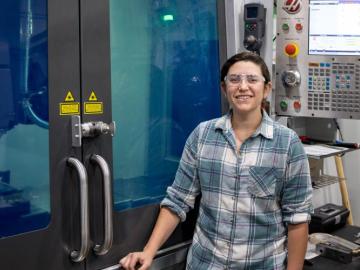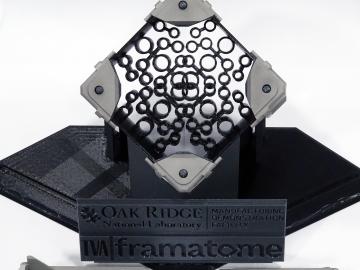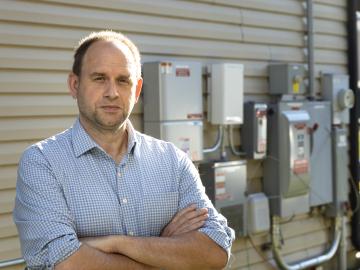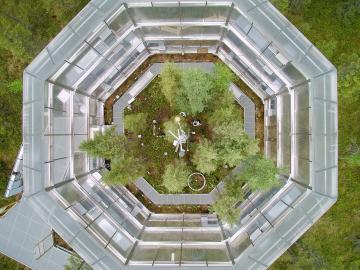
Filter News
Area of Research
- (-) Computer Science (7)
- (-) Energy Science (51)
- (-) Neutron Science (19)
- Advanced Manufacturing (2)
- Biology and Environment (62)
- Biology and Soft Matter (1)
- Computational Biology (1)
- Computational Engineering (2)
- Electricity and Smart Grid (1)
- Functional Materials for Energy (1)
- Fusion and Fission (10)
- Fusion Energy (8)
- Isotopes (2)
- Materials (23)
- Materials for Computing (4)
- Mathematics (1)
- National Security (29)
- Nuclear Science and Technology (12)
- Nuclear Systems Modeling, Simulation and Validation (1)
- Sensors and Controls (1)
- Supercomputing (88)
News Topics
- (-) Advanced Reactors (6)
- (-) Artificial Intelligence (20)
- (-) Coronavirus (22)
- (-) Frontier (3)
- (-) Machine Learning (13)
- (-) Security (8)
- 3-D Printing/Advanced Manufacturing (83)
- Big Data (11)
- Bioenergy (31)
- Biology (18)
- Biomedical (20)
- Biotechnology (5)
- Buildings (38)
- Chemical Sciences (17)
- Clean Water (10)
- Composites (18)
- Computer Science (45)
- Critical Materials (9)
- Cybersecurity (10)
- Energy Storage (75)
- Environment (59)
- Exascale Computing (3)
- Fossil Energy (3)
- Fusion (2)
- Grid (40)
- High-Performance Computing (10)
- Hydropower (3)
- Isotopes (1)
- Materials (46)
- Materials Science (49)
- Mathematics (3)
- Mercury (3)
- Microelectronics (1)
- Microscopy (10)
- Molten Salt (1)
- Nanotechnology (17)
- National Security (7)
- Neutron Science (121)
- Nuclear Energy (9)
- Partnerships (12)
- Physics (10)
- Polymers (12)
- Quantum Computing (1)
- Quantum Science (10)
- Simulation (4)
- Space Exploration (6)
- Statistics (1)
- Summit (10)
- Transportation (68)
Media Contacts

To better understand how the novel coronavirus behaves and how it can be stopped, scientists have completed a three-dimensional map that reveals the location of every atom in an enzyme molecule critical to SARS-CoV-2 reproduction.
A collaboration between the ORNL and a Florida-based medical device manufacturer has led to the addition of 500 jobs in the Miami area to support the mass production of N95 respirator masks.

Growing up in Florida, Emma Betters was fascinated by rockets and for good reason. Any time she wanted to see a space shuttle launch from NASA’s nearby Kennedy Space Center, all she had to do was sit on her front porch.

The Transformational Challenge Reactor, or TCR, a microreactor built using 3D printing and other new advanced technologies, could be operational by 2024.

Oak Ridge National Laboratory researchers have developed artificial intelligence software for powder bed 3D printers that assesses the quality of parts in real time, without the need for expensive characterization equipment.

Oak Ridge National Laboratory researchers have developed a machine learning model that could help predict the impact pandemics such as COVID-19 have on fuel demand in the United States.

Oak Ridge National Laboratory scientists evaluating northern peatland responses to environmental change recorded extraordinary fine-root growth with increasing temperatures, indicating that this previously hidden belowground mechanism may play an important role in how carbon-rich peatlands respond to warming.

Joe Hagerman, ORNL research lead for buildings integration and controls, understands the impact building technology innovations can have during times of crisis. Over a decade ago, he found himself in the middle of one of the most devastating natural disasters of the century, Hurricane Katrina.

Scientists at Oak Ridge National Laboratory have demonstrated a direct relationship between climate warming and carbon loss in a peatland ecosystem.

Researchers at Oak Ridge National Laboratory developed a method that uses machine learning to predict seasonal fire risk in Africa, where half of the world’s wildfire-related carbon emissions originate.


